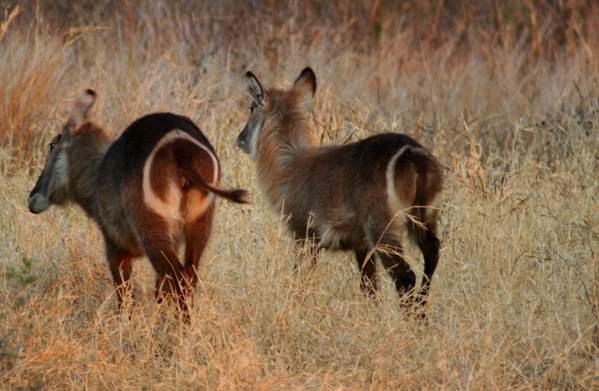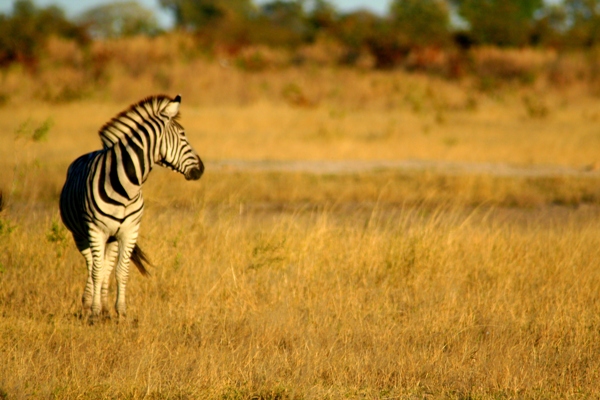- Using an example from a trip to Zimbabwe and Botswana, Jeremy Hance writes about the words we choose matter when it comes to conservation.
- A trip to Africa to see its wildlife should be an experience that goes well beyond entertainment: it should be educational, enlightening, moving, spiritual and, ultimately, transformative.
- When a guide refers to species by silly nicknames, one can’t help but feel that the guide places little value on their own wildlife.
- This is an insider story. To read, please become a member.
The words we choose matter. Benjamin Lee Whorf, an influential U.S. linguist, theorized that the language one speaks directly impacts our thoughts; he is quoted as saying, “Language shapes the way we think, and determines what we can think about.” If this is the case, then those who believe in conservation must select their words wisely.
My wife and I recently traveled to Africa where we visited wildlife parks in Zimbabwe and Botswana. The animals we encountered and the scenes we were fortunate enough to witness proved so beautiful and wondrous that I have a difficult time describing them — at least in any way that accurately depicts the experience.

Although our trip was amazing, an aspect of it troubled me as we left. The first instance was at Chobe National Park in Botswana, when our guide referred to the impalas we were watching as “Africa’s McDonald’s.” The reason for this, he explained, after failing to get the chuckles he may have expected, was because impalas have black marks on their rump, outlined by white, and when their tail is positioned just so the marks appear to make an “M.” It’s not a great likeness of the ubiquitous McDonald’s logo, but somehow the antelopes attained the nickname (also apparently because they are “fast food” for lions) and now can’t shake it off.
I was a little troubled that the guide didn’t take that moment to tell us something about the impala’s natural history, such as its ability to jump 9 meters (30 feet), or the fact that it is active both during the day and the night, or that its social structure is flexible enough to allow herds to change group structures depending on food availability.

It was a small thing, all in all, so I didn’t think about it again until we visited a private wildlife park in Zimbabwe, and our guide told us the same thing. Only this guide took it one step further: every time we would see an impala he would boisterously call out “McDonaaaaald’s!” instead of referring to it by its common name, impala, or, I even wondered, why not its scientific name, Aepyceros melampus?
As our trek wore on, I realized this had become a trend. Zebras, instead of being zebras, were “donkeys in pajamas!”, while, worst of all, was the name give to the waterbuck. This antelope has a white circular mark on its hindquarters, and so the guide called it “toilet-seat buck!”, his voice ringing out over the savanna.

Now, this got me thinking. If what we choose to name something matters, if it in a way shapes our perception and thoughts, then what did it mean to tourists that these animals, which they may only see in the wild once in their lifetime, were referred to as “McDonald’s,” “donkeys in PJs,” or “toilet-seat buck”?
Seeing animals in the wild, watching the way they move about their natural environment, should be an experience of awe and profound respect. It should be a moment to remember. But if one’s guide is calling the animals nicknames that are silly and even demeaning, how can one really see these animals for what they are?
Both the reserve in Zimbabwe and the park in Botswana exist, at least in part, for the conservation of species, yet how could conservation be a success if we demean the species we asking people to help conserve?

This train of thought led me to other phrases common in the industry. In Africa, parks and reserves are called “game parks.” This is leftover language from the time when the majority of these places were literally for the purpose of “game,” i.e. shooting animals with rifles. While there are still true game parks in Africa (where anyone can pay to shoot pretty much any species), the majority of reserves are places for the conservation of wildlife. Why not, then, call these parks what they are: wildlife parks instead of game parks?
Just think about the difference in these two names: small, but important. When I think of “game,” I think of animals that survive and are managed simply to be shot for human pleasure — “trophy” hunting, as it were. When I think of “wildlife,” I think of many species interacting, of ecosystems. While calling it “game parks” may be a cute echo of the past, is it worth retaining the phrase given the image it presents, whether conscious or subconscious?

Along the same vein is the propensity for Africans, and tourists, to refer to the “Big Five.” Like “game parks” this is an archaic reference to when people visited the bush to hunt animals instead of view them. The Big Five are the five most difficult animals to kill: the elephant, lion, African buffalo, leopard and rhino. The phrase has also come to mean the five animals that tourists most want to see; not because these are necessarily the species an individual tourist most hopes to see (birders, for example, will be disappointed by the Big Five), but because it’s what tourists are told — over and over and over again — that they should want to see. Unfortunately this establishes pressure on the guides to constantly look for the Big Five. But why the Big Five? Why should African parks and guides be chained to a list that only made sense when people walked out into the bush with a firearm? Why not the Big Ten, like elephant, lion, African buffalo, leopard, rhino, giraffe, hippo, hyena, Nile crocodile and cheetah? Or better yet, why not ditch the list altogether and just enjoy the wildlife that happens by you, big or small, the object of past hunters or not.
Once our guide in Zimbabwe realized that my wife and I were engrossed and interested in the animals’ ecology and not their nicknames, he actually dropped his veneer and began to explain passionately about the animals we were seeing. I thought then that perhaps calling the animals by nicknames was meant to keep tourists entertained.

But isn’t this emphasis on entertainment dangerous in itself? Animals were not put on Earth to entertain us. If we view the value of biodiversity and nature as merely for our entertainment, then we will only care about conserving species and environments we find especially likeable. We, however, know that natural ecosystems are worth far more than entertainment. Along with providing essential services for our own survival, they also have deep spiritual, cultural and psychological worth, not to mention the moral beliefs underlying all conservation efforts.
A trip to Africa to see its wildlife should be an experience that goes well beyond entertainment: it should be educational, enlightening, moving, spiritual and, ultimately, transformative. When a guide refers to species by silly nicknames, one can’t help but feel that the guide places little value on their own wildlife (though I suspect it’s more a case of them feeling pressured by a world that values entertainment more than reality). Instead, I hope guides will share both their knowledge and love of their nation’s wild lands, instilling respect for the creatures tourists are viewing and imparting upon the visitors the importance of conservation efforts for the survival of many of Earth’s inhabitants.

In the end, few people would devote time, energy and funds to save the “toilet-seat buck” or the “McDonald’s antelope,” but it is worth everything to know that, in our world, a group of impala graze on the dewy foliage; or a male waterbuck with its tall, strong horns shelters itself in the trees; or that a zebra’s distinct stripes can still flash against an African sunrise.
Words matter; let’s put them to better use.
This story originally appeared on Mongabay October 28, 2009 and later appeared in Jeremy Hance’s book, Life is Good. Photos were updated when this story was re-posted in November 2018.
